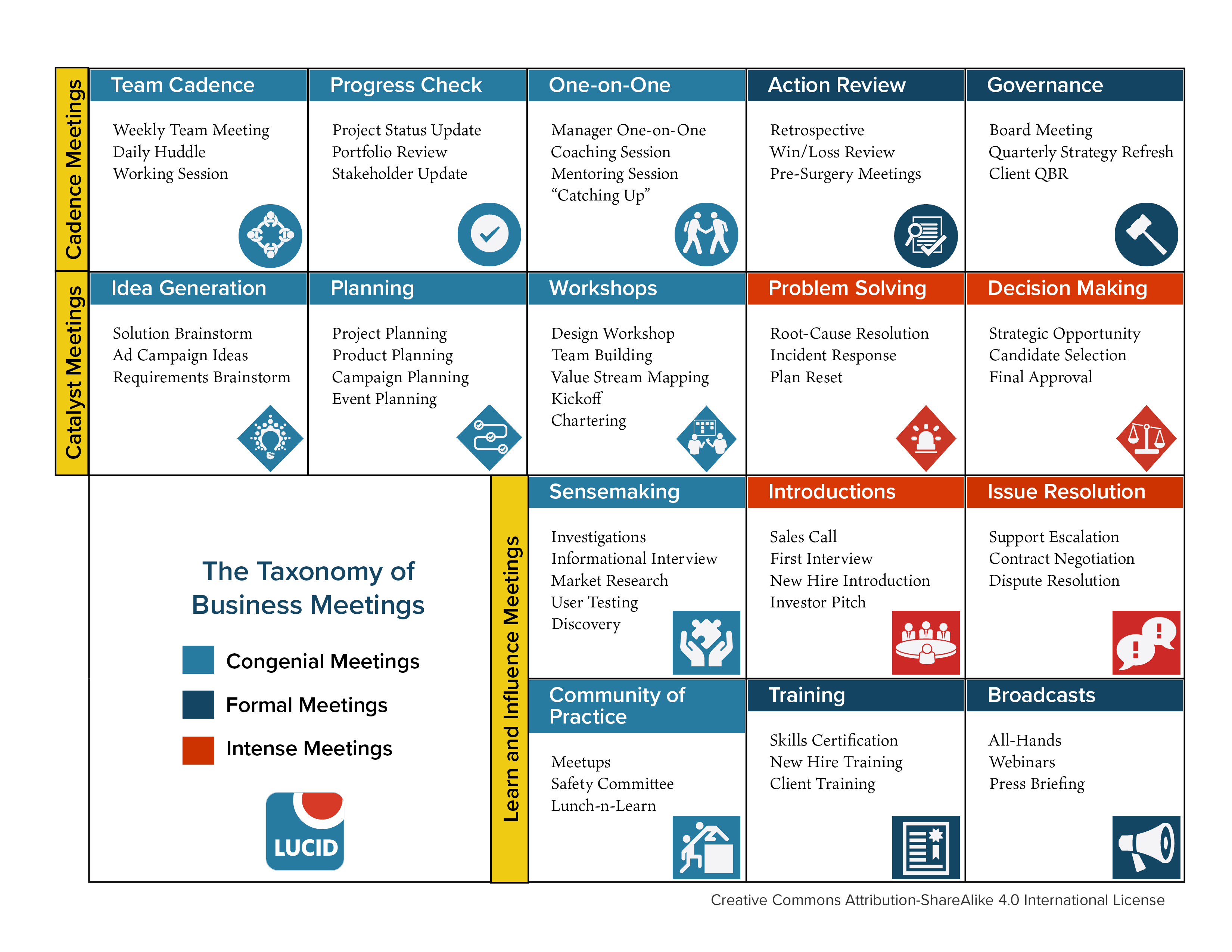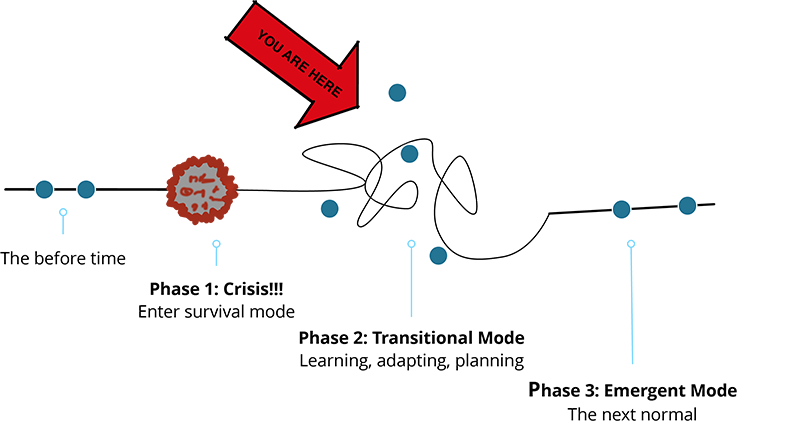Meeting in Times of Rapid Change and Crisis
On April 1, 2020, we hosted a webinar with principals at the Mission Critical Teams Institute. We explored the communication practices business teams can learn from mission critical teams (firefighters, military, medical, and others who handle emergencies for a living) as we all work to adapt in times of rapid change.
Our Guest Presenters

Dr. Preston B. Cline
Preston is the Co-Founder and Principal at the Mission Critical Team Institute where he spends his time as Director of Research. Before turning to research, Preston worked as a Wilderness Emergency Medical Technician, an NAUI Rescue Diver and an Ocean Lifeguard Trainer. As an instructor and consultant, Preston serves teams working in military special operations, emergency medicine, tactical law enforcement, aerospace, and urban and wilderness fire fighting.
Coleman Ruiz

Coleman is the Co-Founder, Principal, and Director of Performance at the Mission Critical Team Institute (MCTI). Before founding MCTI, Coleman served 13 years of active duty with the U.S. Navy as an officer in the Naval Special Warfare community (U.S. Navy SEALs). Today, Coleman serves mission critical teams with Preston, elite athletic teams, and multiple organizations that serve veterans in transition.
Much to my very great dismay, the recording didn’t process correctly.
Also, during the webinar, someone broke the back window of my car. Disappointments abound, but as Scotty at NASA once reminded me, so do solutions and duct tape.

For those of you who missed the live event and were promised a recording, I apologize. I’ll try to tape together the key ideas here. If you attended, please help us all out by adding any important notes I missed in the comments below.
Table of Contents
Feel free to skip around! This is long.
- Introductions: Why Have This Conversation Now
- The Difference Between Routine vs Critical Communication & an Opportunity to Contribute
Recommended Business Meetings:
Introductions: Why Have This Conversation Now
We began by asking everyone about the challenges and opportunities they were facing.
Today’s Challenges and Opportunities
The Challenges
Which challenges are you facing today?
Here are participants’ answers to this multiple-choice poll.
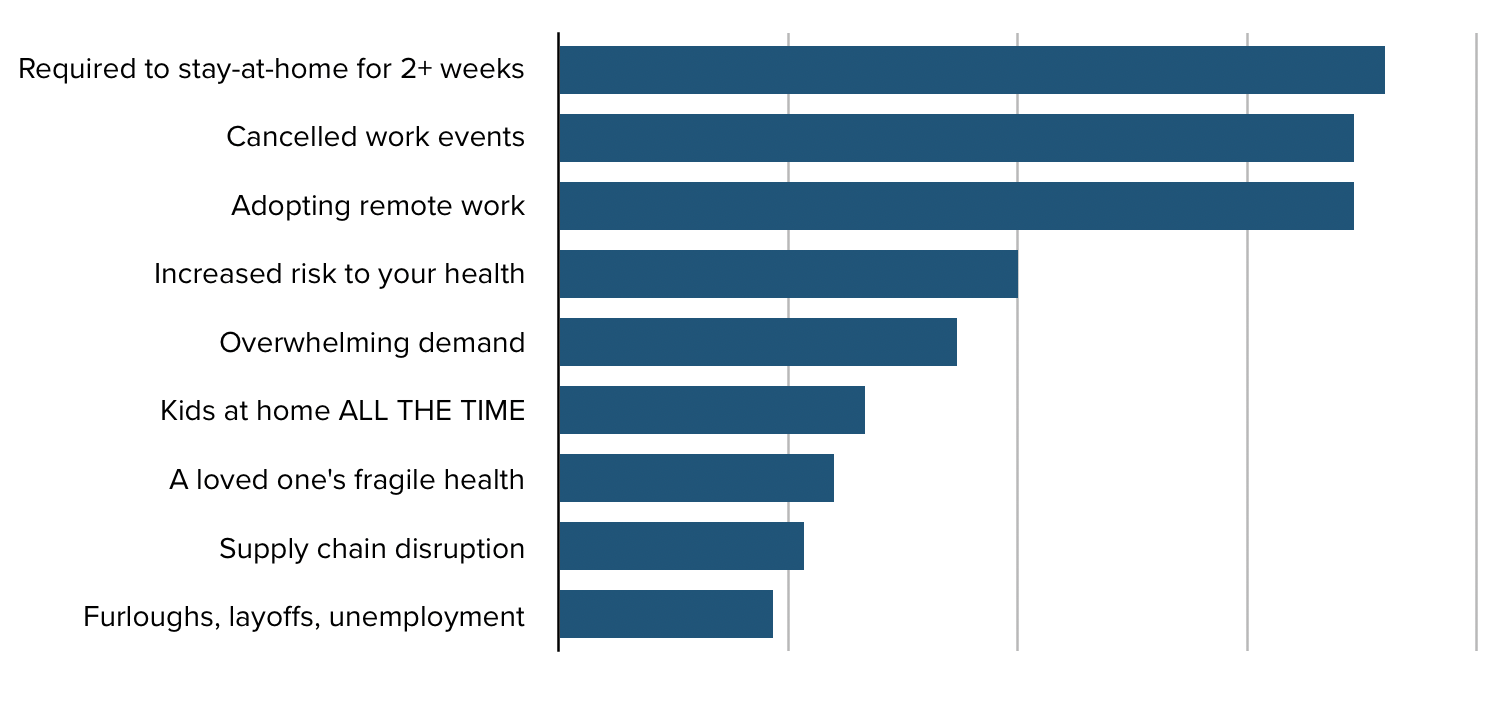
The Opportunities
What one opportunity recently became possible for you?
These were their replies in chat.
- More time for training and planning
- Time for new service development
- My wife is trying to talk me into a puppy
- Working in pjs
- More time for training- webinars, etc for work from home
- Gone independent
- Online presentations
- Connecting with people we haven’t talked to in a while
- More flexibility in my daily schedule, more time with family
- Spend more time with my college age son.
- More chatting with children and grandchildren
- Resetting work and civic priorities; opportunity to learn more tech tools
- New level of prioritization and focus!
- Better connection across countries and functions
- Getting to sleep a bit later with no travel time
- I finally have mental time to learn a new language (Korean)
- More writing
- Hearing from others about how they’re learning to work remotely, and what they need.
- More opportunities to talk about effective remote work strategies
- Reconnecting with many people
- Forced to change my training approach from physical to remote. The results are improving.
- Opportunity to work remotely with a team that before would have required me to travel to Mexico City
- More time to do the tasks I have put off.
- Not to commute
- Remote consulting and facilitation had been challenging – now it is expected.
- Getting to work on projects that I did not have time for when always interacting with clients
- Getting myself better organized
- Many new discoveries about technology
- Co-workers resistant to meeting remotely are now doing it out of necessity.
- Starting up more remote work
- Setting family agreements – everyone’s helping out more
- Launch an implementation of a new hub for remote collaboration
Looking at the list, John Keith noted:

“I see a lot of near term opportunities to focus and complete on outstanding items in this list. Going forward, it will be interesting to see how our work focus changes to embrace these new opportunities. That’s the optimist view. :)”
Navigating to a Foggy Future
We scheduled this webinar in response to all the questions we’re hearing from leaders who aren’t sure how best to communicate with their teams during these complex and rapidly changing times.
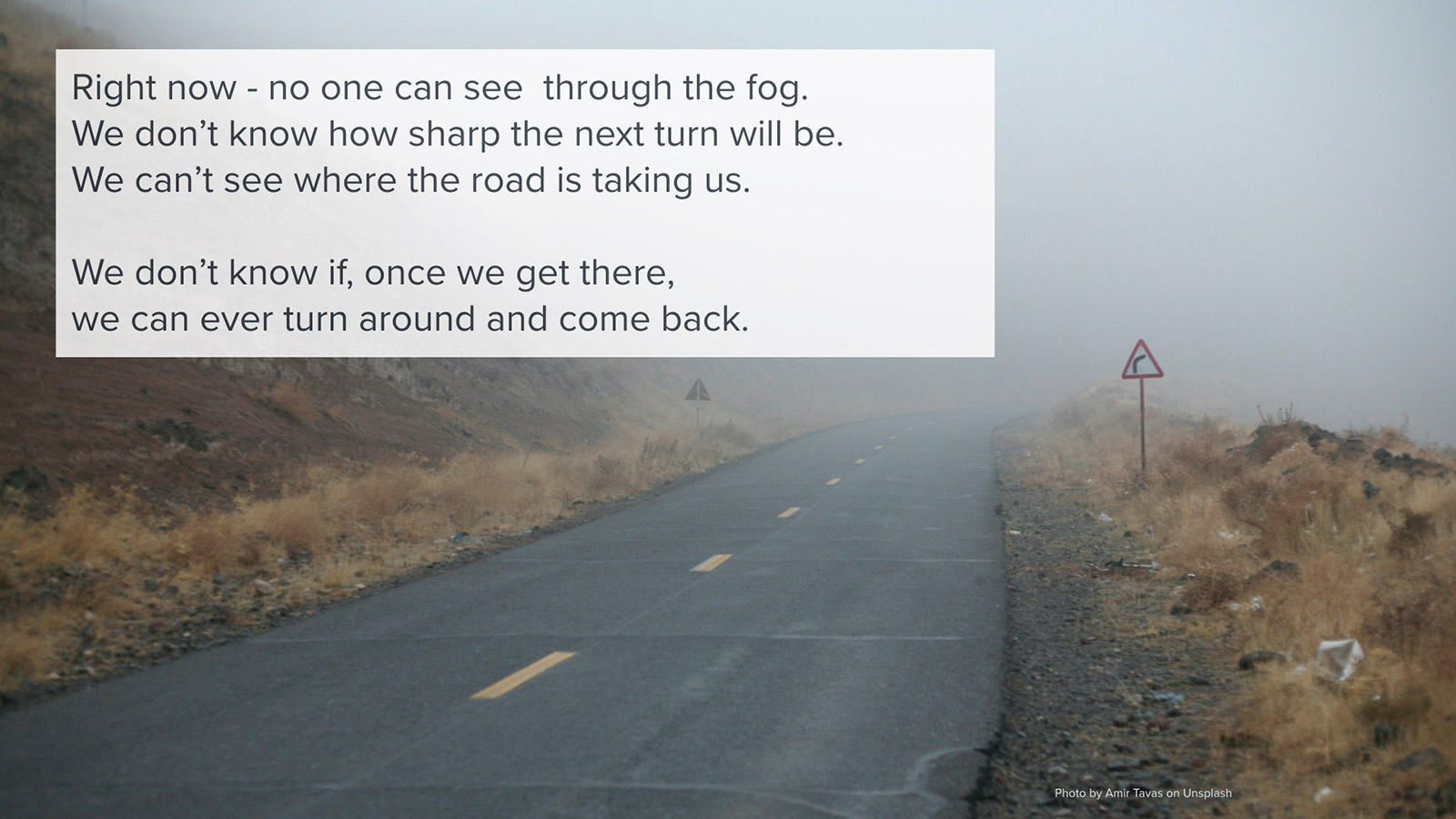
In the absence of certain knowledge, we all create a working theory–our own story–to fill in the blanks.
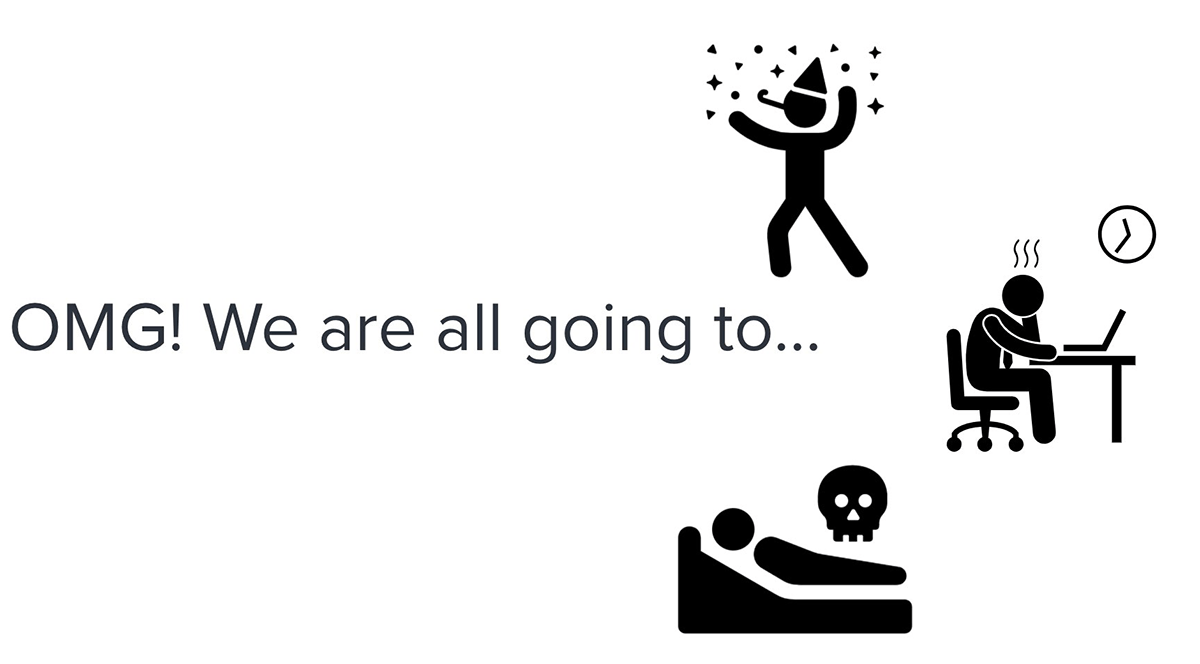
The communication systems we relied on in the past to share information and keep working moving forward have broken down.
In their place, we’re hearing problems like these:
Problem: Email Explosion
“The amount of email I get has quadrupled. There are so many updates and so many requests for replies buried in there that I can’t even find what I’m supposed to reply to.”
Problem: Chatty Chatty Chat Chat
“We moved to (Teams, Slack…) and now my team is in there all day chatting. There’s some work stuff and personal stuff and I love that we can keep in touch, but it’s overwhelming. When I was in the office, I used to at least get a lunch break, but now I’m not sure when I can step away!”
Problem: Mixed Messages – I Need You to Do More, I Care, This is Really Bad, We’re Going to be Ok.
“As the CEO, I know my people are worried about their jobs. They should be, because revenue is down 50%. I don’t want to tell them that, though, because I don’t want them to freak out when I need everyone working harder and smarter right now.”
These quotations are paraphrased from multiple sources. If this sounds like you, you are not alone.
Email and chat volume is up. Our old reliable reports can’t help us predict what happens next. Leaders operating out of fear alternate between authoritarianism and trying to play ship’s counselor.

Img source: CBS Video / Via tng.trekcore.com
Back to the table of contents ↑
The Difference Between Routine vs Critical Communication
Preston began by helping us all understand the difference between routine and critical communication.
Exercise: Imagine Two Scenarios
- Scenario: You meet with your boss to discuss your work performance. If that goes well, how would you describe the tone of the conversation?
That’s routine communication. - Scenario: You walk into a room and your colleague collapses to the floor. You and the others in the room work quickly to help your colleague. How would you describe the ideal communication style used by you and your colleagues in that emergency?
That’s critical communication.
When asked to consider these scenarios, many people respond with something like this.
| Routine | Critical |
|---|---|
|
|
Preston witnessed a group transition between these types of communication when he observed a team performing open-heart surgery.
You can hear Preston tell this story in this recent podcast episode. Highly recommended. You can also read Preston’s story in this Green Paper.
TIP: I’ve embedded his LinkedIn post and the Green Paper here. Hover over the paper and click the square in the bottom-right corner to get a full screen view.
Request for Mission Critical Workers
Do you work on a mission critical team, or do you know someone who does? If so, please consider contributing to the research described in Preston’s paper above.
The Key Observation
People don’t always recognize the transition from business-as-usual to critical. When they hear Critical Communication, but are expecting Routine Communication, they get upset. It feels rude and insulting, rather than efficient and clear.
My mom, who was a cardiac nurse for many years, listened to the webinar and called me afterward.
“The team Preston observed needed a better training nurse,” she said. “You have to know what each doctor sounds like when things get critical. Some of them get clipped and commanding. Some of them start to whisper. Some of the anesthesiologists start to shake a little bit in that critical moment. A good training nurse would teach those circulating nurses what to watch for on their team, because every team’s different.”
This observation makes the point clear; the way we communicate changes when the situation becomes critical, but that change may not be obvious or intuitive if you haven’t been trained to see it. When people miss the change, they will be too busy being offended to be helpful.
Recommendation
Recognize that you may need to use Critical Communication as you work with your teams to navigate through the fog. To avoid confusion and hurt feelings, teach everyone about the difference between Routine and Critical Communication.
Then, explicitly state when you need to move from one to the next. Remove the need for them to guess.
Tell them. “Now, we’re in a Critical situation.”
Back to the table of contents ↑
Recommended Business Meetings
The first set of meetings below (the All-Hands and Gathering Up) helps your organization figure out what’s going on and get accurate information you can use to make decisions.
You make decisions about what to do using the second set of meetings (Near-Term Planning and AARs).
This third set then makes sure that all the people doing this planning and acting and figuring out can do that work in a healthy, sane way.
Two Meetings that Keep Everyone Informed and Help You Figure Out What’s Going On More Quickly
When we lack accurate information, we make decisions based on our best guesses. As business leaders, we want everyone making decisions based on reality.
These two meetings help everyone better understand what that reality might be.
1. All-Hands Situation Update
Most companies host All-Hands meetings to provide monthly or quarterly updates.
These are usually big Broadcast presentations, much like an internal webinar, designed to:
- Inform everyone about the “Big Picture”
- Align employees with the company’s Higher Purpose
- Inspire a sense of Pride and Loyalty
It’s a kind of show, designed by leadership and the communications group to rally the team.
When the situation changes, leaders know they need to quickly communicate with their employees, so they’ll schedule an All-Hands. The kind of All-Hands they need to run, though, is very different.
During fast-moving situations, these All-Hands should work more like a regular team cadence meeting. They need to:
- Ensure everyone has Facts: accurate and current information
- Align employees with the current Intention and Top Priorities
- Inspire Trust and a sense of being “In It Together”
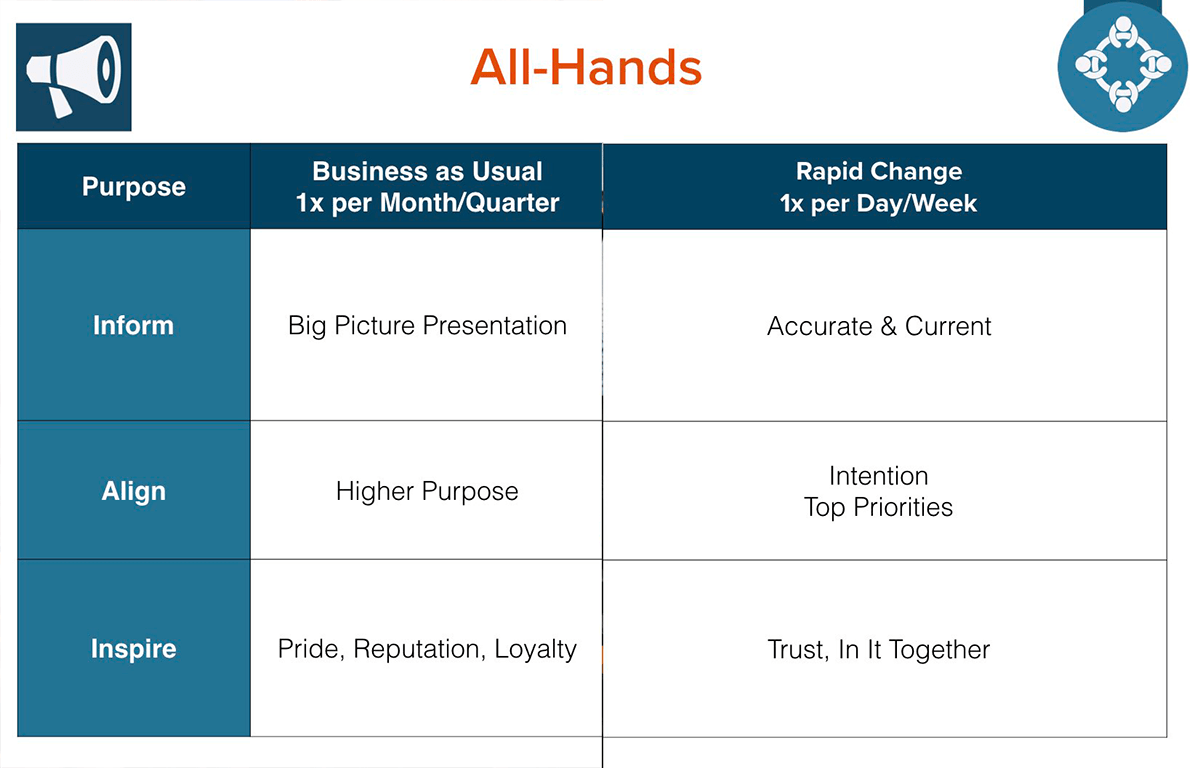
All-Hands Update Recommended Content
Information
- What we know: facts
- What we assume, but aren’t sure about
- What we don’t know and are trying to learn
Alignment
- Our Intention: what we’re hoping to achieve next
- Top priority plans
- Decision-making guidance
Inspiration
- Stories: how teams get through situations like this
- Honest answers
- Inclusion: invite their insights
For more information on running this meeting, view the guide.
2. Gathering Up
As a leader, you have access to information many others don’t. You have a unique perspective on what’s happening in the organization and across the larger context in which you operate.
But you are still (and always will be) one person who can only see so much from where you sit. When facing a rapidly emerging complex situation–when we’re all marching into the fog–we need to activate our entire network’s navigational skills. Just consider how much faster a group of 100 or 1000 or 100,000 can scout out this new territory than your 10-person leadership team could on their own.
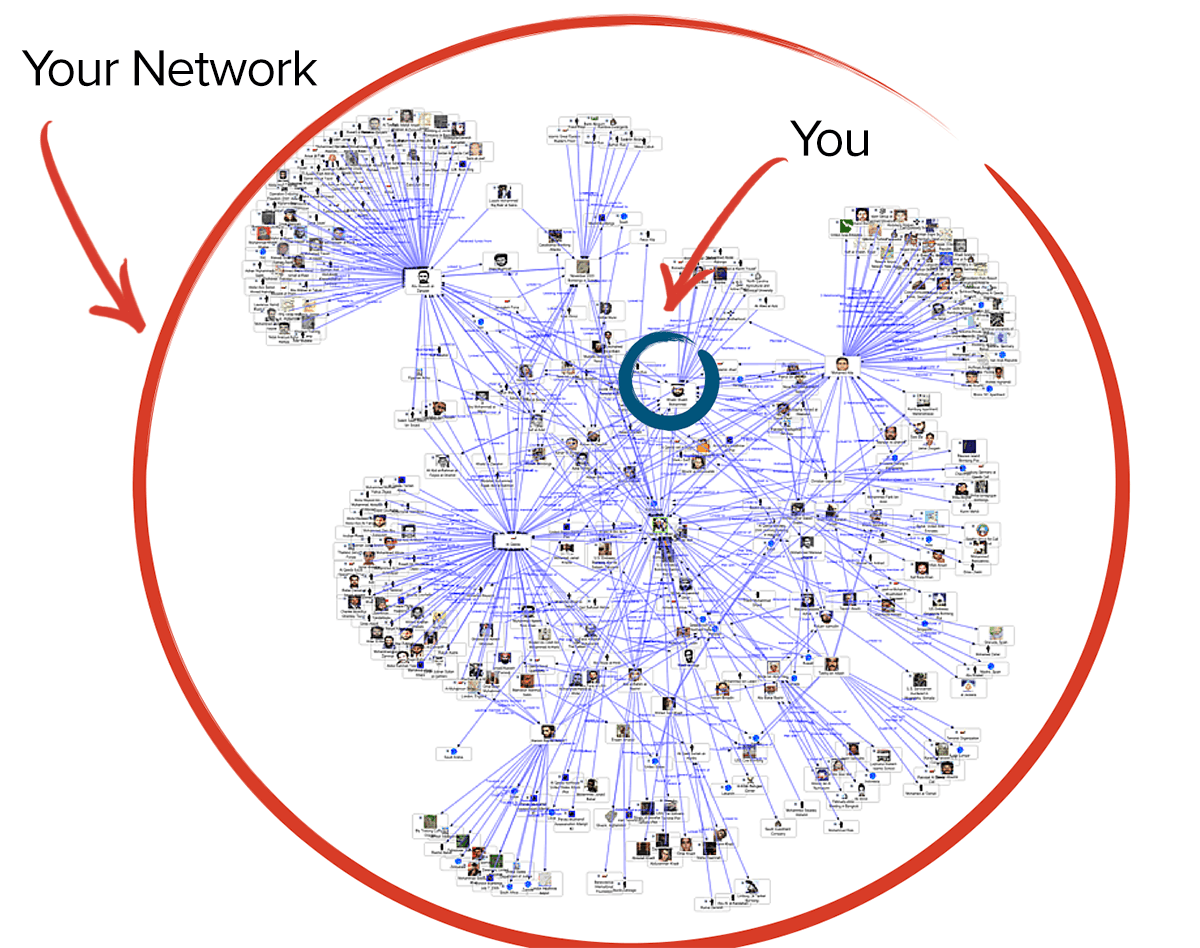
If you don’t already have a thick-pipe communication channel open between all parts of your organization, now’s the time to set that up. Set the expectation that everyone should speak up when they see or learn something that can help your company now.
In very tiny companies, you could simply set up a Teams or Slack channel and ask people to post a note whenever they see something relevant. For everyone else, you want to set up a system that
- Makes it obvious that everyone should speak up (not just the happy chatterbox types) and
- creates a stronger signal-to-noise ratio.
To do that, add time to every team’s regular team meeting where they answer these questions:
Gathering Intelligence and Reporting Out
What we need:
- Answers: What questions do we have?
- Resources Needed: What resources do you need?
What we can share:
- Insights, Observations, Key Learnings:
What have you seen or learned that may help? - Offers:
What can you do that could help? - Recommendations:
What would you do if you were in charge? - From all of this, what are the high priority items others need to see?
To see one way you can run a meeting that keeps your team in-synch and creates these results, try this team check-in/report-out meeting format. This meeting will work for leadership teams, who will decide which information gets shared at the All-Hands, and for other teams who gather information to send back to leadership.
Communication Wisdom for These Meetings
Now, if this style of transparent cross-functional communication is new to your organization, don’t expect an immediate reply from everyone. The fundamental principles of engagement apply here.
Leaders, you must have the courage required to explicitly ask for the information you need. Then, you must provide a safe way for people to provide this information. When you receive information, you must treat it with respect.
- Answer the questions honestly. “I don’t know,” and “I can’t share that for x,y,z reasons, but I can tell you this…” are both valid answers.
- Acknowledge the requests and insights.
- Act on those insights that you can and that align with the intention.
- Express gratitude and give credit. Make people who provide value feel valued.
During the webinar, participants pointed out how important it is to be explicit at all stages. Explain who will see the information they’re sharing, how it will be used, and who takes responsibility for making the final decisions. This clarity works both to create safety and as an acknowledgment that this isn’t your old system. Everything is changing, so until you all find your way through the fog to a new normal, you need to clearly explain what’s going on as if you were starting from scratch.
Preston shared that it’s particularly important to grant everyone wide margins of grace.

“Don’t project intention upon people…A lot of our normal communication contains a bunch of implicit information based on your shared history. So much of our lives have been disrupted you cannot assume that information anymore. As a result, we need to increase both our courtesy and patience. It is important that we do not assume others intentions, if we do not know their personal circumstances. I would refer you to Johari’s window.”
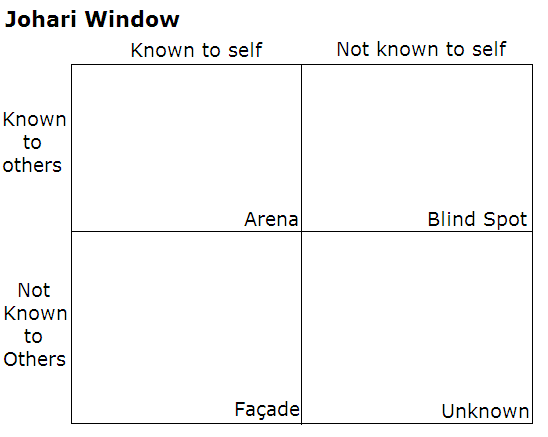
Back to the table of contents ↑
Two Meetings for Creating New Short-Term Plans and Adapting As The Situation Unfolds
We must move forward in uncertainty and not wait for the answers, because otherwise we miss the opportunity to be a part of creating those answers.
Your previous work plans are either partially or entirely disrupted, but you can’t just sit still and wait for everything to settle out. You need a new near-term plan that gets your teams focused on the most critical activities right now.
In this unprecedented situation, there’s no way to know in advance if these new plans will work, so you also need a way to learn and adapt as you go.
Use these two meetings in a fast-loop cycle to plan and adapt quickly in times of rapid change.
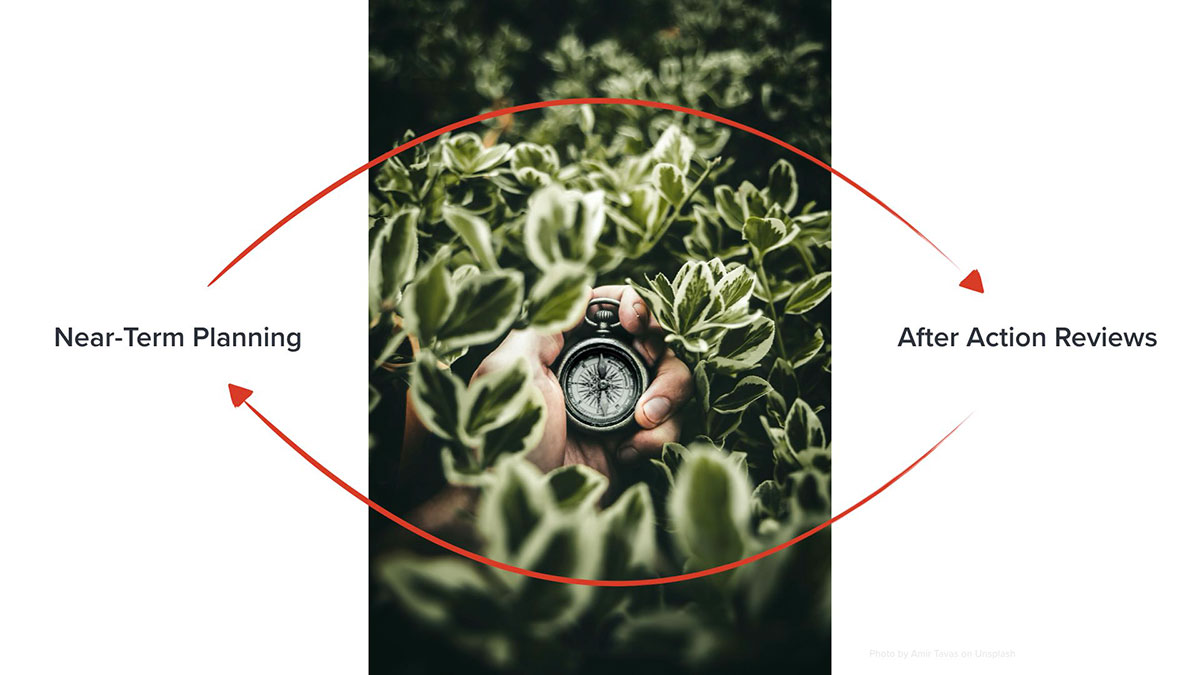
Near-Term Planning
This planning meeting can be used at both the senior leadership and team level. It takes advantage of several simple meeting techniques that help a group efficiently turn a huge soupy mess of possibilities into a focused action plan.
Steps for Creating a Near-Term Plan
- Set Intention
- Pre-Mortem
- Set Priorities: Start-Stop-Continue / Min Specs
- Create an Action Plan
- Closing Review and Appreciations
To be most effective, this meeting requires preparation. Ideally, you want the person running the meeting to be someone who isn’t critical to the discussion. You also want everyone to come prepared with their ideas about the activities your organization should start, stop, and continue in the near term.
For detailed instructions and tips for adjusting this meeting to fit your group’s unique situation, check out this guide.
Coleman, who spent over a decade helping special ops teams create high-stakes mission plans, shared this tip:

“When you’re creating your contingencies, you want to make sure that the most dangerous scenario you’re planning is very different from the other main scenarios. When you discover that your most dangerous contingency and your primary contingency have started to converge, that’s when you know you’re in real trouble.”
Experts specializing in complex adaptive situations (like the one many organizations face during the Covid-19 pandemic) recommend identifying multiple actions that you can try at once. For example, if you are trying to fill a revenue gap, you might assign one team to investigate government assistance, one team to work on creating new revenue streams, and another team to investigate potential expense reductions. To solve your immediate problem, you may need all or only one of those to work out, and by having them all work in parallel, you’re increasing the odds of success.
That leads to the next meeting you need to run.
After Action Reviews
After Action Reviews (also known as AARs or retrospectives) are used by teams to quickly learn from what they’ve tried, then make adjustments to how they’ll work going forward. There are lots of variations on this meeting, all sharing this common underlying structure.
The Basic AAR Steps
- What happened?
- So what did we learn?
- Now what are we going to do differently?
For guidelines on running an AAR, visit the Lucid Meetings page on Action Reviews. You’ll find links to several resources for AARs there, including an excellent guide written by the Wildland Fire Leadership Council.
Back to the table of contents ↑
Deep Dive on AARs
Teams that regularly run AARs learn more quickly and adapt more successfully than others. The frequency of these meetings changes your team’s rate of learning, so if you want to learn really fast, you’ll keep your AARs short and run them often.
Because AARs play such an important role in a team’s ability to quickly adapt, they’re a key practice for mission critical teams.
In his work with MCTI, Coleman built on his years of military service and MCTI’s body of research to analyze how special ops teams get the most value from AARs. These teams are all trained to run regular AARs and get lots of practice in these meetings, which creates an opportunity for researchers to compare the best and worst practices.
In the webinar, he shared these insights.
Coleman’s AAR Advice

First, recognize that there are three primary reasons for an after action review:
1. Rebuild a common view of the event.
Envision a baseball field. Every player is in the same game, but they’re all standing in different places. You’ve got the player on first, the player on second, the pitcher, the catcher, the player way out there in the outfield. Each one of them sees a very different view of the same game.
When they come together to review each play, they share what they could see from where they were standing and together, build a larger common picture.
Teams use AARs to do the same thing. Each person involved in your work sees the work from a very different perspective. The first step in the AAR is explaining “What” in as factual a manner as you can, so that everyone gets a common view.
2. Move into a learning mode based on honest assessment.
With that common view of the event–the honest assessment of what really happened–then your team can talk about the lessons you learned.
As a group, discuss: what can we learn from this? What’s working, what’s not working and what’s causing that? What should we change about our approach going forward? What one or two experiments do we want to try next?
“It’s critical to make sure that this isn’t coming from a place of judgement,” Coleman emphasized. “The AAR is not a courtroom. It’s a lab. There’s no rank in that room. It’s just us as individuals, working to make sense of the situation. It isn’t about who messed up or who should have done what – it’s constructive feedback about the work.”
To make that distinction extremely clear, Coleman shared that some teams move to an entirely separate space for AARs, physically moving themselves out of the room where they make critical judgements about plans and into a dedicated space for honest, critical examination of the work.
Other teams will place an object in the middle of the table and point to it saying “That. That right there is the work we’re talking about.” While this might seem corny, it works to gives everyone something external and objective to point at, and helps them speak with the degree of non-attachment required for achieving the best results.
3. Reconstitute the team based on renewed alignment.
AARs can be emotionally charged, especially when they follow high-stakes actions. Any time teams reflect on work done under high-stress, there’s an opportunity for bad feelings and “residue” from the event to linger. If this emotional impact sits unaddressed, it builds up and damages the team’s ability to work together.
AARs give the team time to recreate their understanding of what happened, share and work through the constructive criticism that needs to be addressed, then confirm their commitment to working forward together.
Coleman shared:
“In these mission critical teams, these conversations may not sound like much. Sometimes it’s just one guy saying to another ‘Hey, I understand why that happened, and I still trust you. We good?’ and the other guy says ‘We’re good.’ It may not look like much, but it really makes a difference.”
Back to the table of contents ↑
Three Meetings that Take Care of Your Teams

New Working Team Agreement
If you need to change how you’re meeting, it means that your normal ways of communicating aren’t working right now.
During the Covid-19 crisis, many teams who used to work in the office are now working entirely from home. Other businesses are managing unprecedented demand. Some are operating with reduced staff, or assigning employees to tasks they’ve never done before, like making people queue up in well-spaced lines before they enter a grocery store.
Any time your team changes or that the way your team works together changes, you’ll save a ton of time and grief by quickly establishing a clear set of working agreements.
What to Include in Your Working Team Agreement
- Availability and response times
- Communication architecture: the method, frequency, and systems you’ll use to share information
- How you’ll collaborate on work in progress
- How you’ll celebrate and connect as fellow humans
Of all these changes, moving a co-located team to 100% remote work is the one most likely to impact knowledge workers and also the one managers are least likely to manage gracefully.

If that’s you, please check out this template. In 2015, Lisette Sutherland created this guide for building a working team agreement for remote work. Who knew that would become so popular?
How to Create a Remote Team Working Agreement
One-on-Ones
Last year, Cisco shared data showing that employees who have weekly check-ins with their team leaders are more engaged and more productive. These weren’t traditional check-ins, though.
Instead of managers calling employees in to report status, these one-on-ones focus entirely on the needs of the employee. The goals:
- Find out how to help with anything that’s blocking the employee’s performance
- Take a moment to recognize and care about each other as people
At Cisco, employees write the answers to these questions before the one-on-one and send those answers to their team leader.
One-on-One Questions
- What are your priorities this week?
- How can I (the team leader) help?
I wrote more about this practice for Inc. Magazine., as it’s a good practice at any time. At times of rapid change and crisis, this becomes a critical practice because as a leader, one of the best ways you can make sure your teams successfully navigate the fog is to regularly clear any barriers out of their way.
For more details on running performance-enhancing one-on-ones, including 25 other questions you might find useful, view this guide.
Random Coffee Dates
Final recommendation: teams working across locations, departments, and other divisions often benefit from the sharing of ideas that arise when people encounter each other in the halls and at company events.
Innovation Centers from MIT to Apple to the old Bell Labs intentionally designed their office spaces to increase the frequency of these random encounters, because they knew these exchanges inspired creative solutions. They designed for serendipity.
With everyone working at home, it’s really hard to accidentally bump into colleagues from different parts of the organization.
Emily Webber’s all-remote team recognized this problem and decided to give serendipity a little push. They use a bit of randomizing software to pair each employee with one other. Then these two meet via videoconference and have an agenda-free conversation. You can read more about this here:
Assisted Serendipity, Random Coffee and the power of the unstructured meeting
Tip on closing the loop: If your team goes on random coffee dates, make sure to ask them about any insights they gained when you gather up in your team meetings!
Back to the table of contents ↑
Takeaways
At the end of the webinar, we asked participants for the key takeaways. Here’s what they said:
The insight about communication modes:
- Noticing when someone’s transitioning from routine to critical communication
- Make the transition from routine to critical clear!
- Being clear when moving from ideas mode to decision mode
Wisdom for After Action Reviews
- I loved the after action review part … Really inspiring perspectives
- Including the «no rank»
- It is not a courtroom, it is a lab (learning lab). Be constructive. Not too judgmental.
Change the structure and type of meetings:
- Change the cadence of meetings.
- The structure – pre-mortem, post-mortem, after action review, we need it desperately
- Also random coffee date to keep disparate parts in communication
Treating each other well:
- Agree with Preston that we need to check on folks. Pause and notice who has not checked in for a while.
- That people will fill in the gaps if they don’t hear it from leadership
- Takeaway: the way that Coleman and Preston “amplify” each other and seek that out.
- Maintain human connectivity by not relying on texts and non visual communication
- Be present to what’s happening in that moment!
In general:
- I am looking forward to taking these “challenging times” tips back and not going back to work as usual.
- Excellent session and insights. Thanks a lot to our presenters. Some gems and pearls of wisdom.
- This is really good stuff. Thank you so much
- Fantastic session. thank you!
I agree! It was a really fun session, and I’m still pretty upset that there’s no recording, because I want to watch it again too.
If you were there, please help me fill in the gaps. What stories or insights would you highlight? Please add those to the comments.
Whether you joined us live or not, what are your takeaways? And how can you amplify what you see here? Add your comments below so we can all build and learn together.

